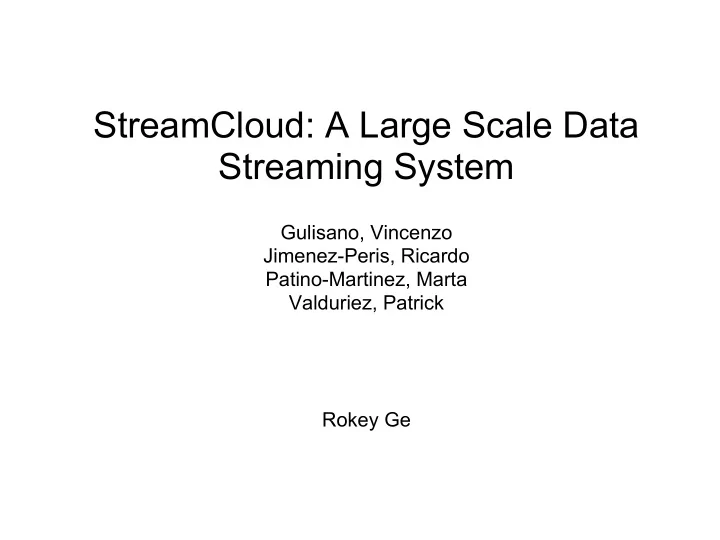

StreamCloud: A Large Scale Data Streaming System Gulisano, Vincenzo Jimenez-Peris, Ricardo Patino-Martinez, Marta Valduriez, Patrick Rokey Ge
Outline The need for Data Stream Processing Current Stream Processing Engines Introducing StreamCloud Scalability, transparency, portability Evaluations My thoughts
Data Streaming Applications that require real time processing of data streams Financial data analysis Sensor network data Military command & control Store and process can't deal with the high volume and low latency requirements Stream processing engines (SPEs)
Data Streaming Data stream: infinite append-only sequence of tuples Queries are defined over one or more data streams Each query is a network of operators Stateless: filter, map, union Stateful: join, aggregate (computation over sliding windows of tuples)
Data Streaming Emerging applications are pushing the limit of SPEs Network monitoring, fraud detection Distributed SPEs Distribute queries, or operators to individual nodes Parallel SPEs Same queries or operators on different nodes in parallel
SPEs Aurora [D.J.Abadi et al] Splitting the load across several nodes running the same operator. Data stream go through single nodes,bottlenecks. Flux [M.A.Shah et al] Exchange parallel operator, specific to SPEs Limited evaluations Simulated, limited scope
StreamCloud A data stream processing system Scalability: scale with respect to the data stream volume Transparency: parallelisation of queries without user intervention Portability: independent of underlying SPE
Scalability Query cluster strategy Full query allocated to a subcluster of nodes Nodes execute on a subset of input Communication across nodes, at least for each stateful operator
Scalability Operator-cluster strategy Each operator to a set of nodes Communication between nodes of one subcluster to the next
Scalability Subquery-cluster strategy Subquery: a stateful operator followed by stateless operators; or the whole query if no stateful operator Subquery to nodes
Scalability Subquery-cluster strategy Minimum number of communication steps Minimum fan out cost Parallelization of Staeless subqueries Each input tuple can be processed by any node Load balancer applies round-robin to distribute
Scalability Parallelization of Stateful Subqueries Join and Aggregate (group-by) Each input stream split by LB into N substreams hash(A)%N to distribute tuples Cartesian Join Each tuple is sent to M=sqrt(N) nodes %M to distribute
Scalability
Transparency Parallelization result should equal to non parallel version Input Merger: takes timestamp ordered substreams from LB and generate ordered substream Optimisations Merge stateful subqueries if they share same aggregation method Merge union with IM, filter with LB
Evaluation Targets to measure the scalability The number of processors The window size Methodology Increasing input loads for different configurations StreamCloud instances process tuples until it overloads Throughput: tuples/comparisons per second CPU usage, queue length
Evaluation setup 60 nodes with 160 cores Multiple instances of StreamCloud per node for multi-core nodes Baselines: centralised SPE on one node; two StreamClound instances on one node
Evaluation Plan Scalability of each individual operator Scalability of full queries Comparison with query-cluster and operator cluster strategies Increase system size while maintain fixed window size to handle increased input node Scalability in terms of numbers of instances per node
Crazy charts
Crazy charts explained Operators scale well Subquery-cluster is 2.5 to 5 times better than query-cluster and operator cluster Scale with cores too Scalability maximised!
My thoughts ++ Subquery-cluster strategy provides better scalability Load-balancer & Input-merger implemented with standard stream operators Detailed evaluations over real implementation (albeit crazy charts)
My thoughts -- Other operators? (e.g. Bsort, ReSample) How does it handle network imperfections? Delayed, missing, out-of-order data Broken node Independence unproven. What about other SPEs? Evaluations do not contain comparison with other systems
Questions? ??? ?? ?
Recommend
More recommend